Understanding the way trees reduce soil erosion
Leith Knowles, New Zealand Tree Grower February 2006.
New Zealand loses between 200 and 300 million tonnes of soil every year to the oceans – a rate about 10 times the world average. Erosion is fairly light to moderate over half of the country, but severe to extreme on 10 percent of it. Downstream effects can be disastrous for those involved, as shown by the 2004 storm in the Manawatu.
It is widely accepted that soil erosion under forests is much less than under other forms of vegetation cover such as pasture, as the trees have deeper stronger root systems. Reduction in mass soil erosion following tree planting on pasture land can be predicted from estimates of the dry weight of tree roots and their strength. This information, combined with data on loss of root tensile strength after felling, provides a basis for an understanding of the way trees of different species, managed at different stockings and rotation ages, reduce soil erosion over consecutive rotations.
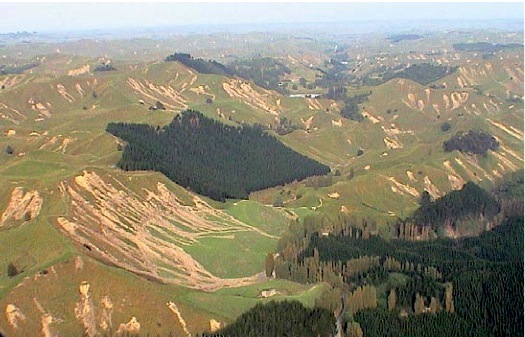
Species differences
The main tree species planted on steep hill slopes in New Zealand are radiata pine, Douglas fir, and poplar. Poplar is usually the species of choice for erosion control on hill country pasture land. However the benefits of such planting may be less than commonly thought.
Production woodlots and forests of radiata pine and Douglas fir on steep country have a dual production and protection role. One has only to fly over steep erosion-prone land already planted in trees, especially after a storm, to appreciate their effectiveness in reducing erosion. The other more sobering conclusion one may draw is that most of our erosion prone land is in pasture, not trees. Pastoral farmers have been slow to adopt sustainable land use practices on eroding land, even with so called farmer friendly species such as poplar.
There is a good relationship between above ground and below ground biomass for woody plants. The larger the tree stem, the greater the root biomass. The relationship between diameter at breast height (DBH) and root biomass for radiata pine, Douglas fir, and poplar is shown in the graph.
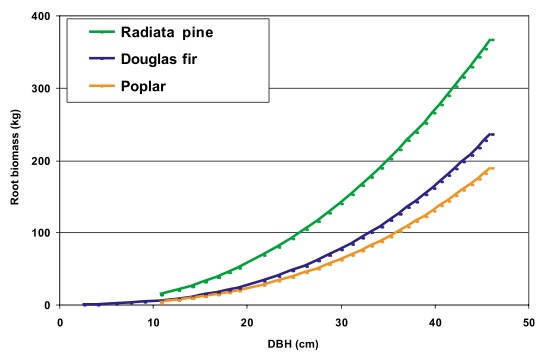
For a given tree size, a radiata pine will have a larger root biomass than a Douglas fir, which will in turn have more root biomass than a poplar. If we compare the same species for root strength, the rankings are reversed. With a tensile strength of 39 MPa (mega-pascals), poplar roots are twice as strong as radiata pine at 19 MPa. Measurements of Douglas fir roots in coastal Oregon showed a tensile strength of 25 MPa which is 1.3 times as strong as radiata pine.
It would seem logical that the soil holding ability of a tree of a given size should be the product of its root biomass and its root tensile strength. In other words, to compare these three species, we need to multiply the poplar root biomass by a factor of 2.05, and Douglas fir root biomass by 1.3. The result is illustrated in the diagram below which shows the comparative soil holding ability of the three tree species when grown to the same stem diameter.
Each species achieves the same outcome by a different strategy, either by growing lots of roots that are not very strong, or by growing fewer but stronger roots. So provided that trees are grown to the same size, all species can be expected to do a similar job in terms of holding erodable hill slopes in place.
Stocking and site
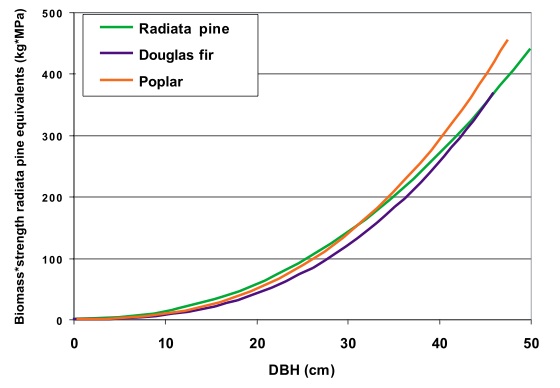
Tree size is affected by growth rate, which will differ widely between species, and by site factors and stocking rates. Poplars grow well on alluvial terraces, but are not particularly happy on steep, exposed hillsides which are the very sites that are erosion prone. Radiata pine, while less productive on such sites, is generally the most site tolerant, with Douglas fir next.
The number of trees per hectare will also be an important factor in determining the effectiveness of plantings for erosion control.
Poplar is often planted as poles, at the widely promoted and recommended rate of 50 or so per hectare. Cost constraints and the desire to retain pasture production reinforce such practices. Radiata pine is usually planted at 800 to 1200 stems per hectare, and Douglas fir at 1250 to 1650 stems per hectare. Both these species are usually thinned to waste to a final crop of 300 stems per hectare and 500 to 600 stems per hectare respectively.
Harvesting
Finally, what happens if the stand is felled and then replanted? Will the hillside slip away in the first storm? The answer is generally no, provided that best practice is followed in the way the stand is logged.
Residual roots continue to hold the soil in place long after the tree has been felled. Measurements of root strength following felling show that a radiata pine root system will halve its strength over 15 months.
This is referred to as its half-life. In other words, 30 months after felling, the effective soil holding ability will be 25% of what is was immediately before felling. For Douglas fir the half-life is reported as 27 months in British Columbia and 46 months in Oregon. Other research has shown that the loss of root tensile strength after felling may be relatively constant for all tree species when expressed as actual loss of tensile strength per month. A typical loss is around 0.5 MPa each month. This indicates that poplar roots should have a half-life of around 35 to 40 months. Rather surprisingly there is no evidence that the actual half-life of poplar roots has been determined.
Thresholds
The radiata pine and Douglas fir Calculators V2 allow the user to predict the soil holding ability for these species, taking the growth rate, silviculture, root strength and root decay for that particular species into account. The output can be copied into a spreadsheet, with profiles from repeated rotations simply pasted into place to show the accumulated soil-holding ability over long time frames. This can also highlight periods of vulnerability between rotations.
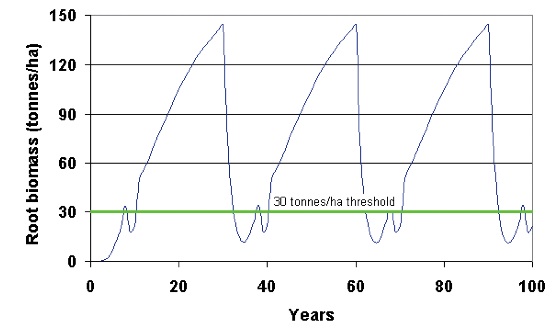
If we base evidence from cyclones Alison, Bernie, and Bola, and other more recent storm events, a rule-of-thumb can be determined.
This gives a minimum threshold of 30 tonnes of radiata pine root biomass per hectare which is necessary to hold soil in place on typical erosion prone hill slopes. For the second and subsequent rotations, root biomass typically falls short of this benchmark for a seven year period, that is seven years out of 30.
So for 77% of the time, the stand should do the job of holding the soil on the hill. For the remaining seven years, there is an annual shortfall averaging 12 tonnes of root biomass per hectare. In other words, over this inter-rotational period, the trees have on average 60% of the root biomass required to do the job. Natural recruitment of shrub species on to the cutover may help to fill this gap. The graph at the bottom of the page shows an example for radiata pine without shrubs against the 30-tonne per hectare threshold. The smaller reduction in root biomass evident when the stand is age eight years is due to the thinning to waste to 300 stems per hectare.
To evaluate a typical Douglas fir regime on a 45 year rotation, the root biomass output from the Douglas fir Calculator V2 is multiplied by 1.3 to allow for the differences in root strength. This shows that once a Douglas fir stand is established, it meets the threshold in 38 years out of 45, and the average shortfall for these seven years is only six tonnes per hectare. In other words, the stand is meeting 80% of the benchmark over this inter-rotational period.
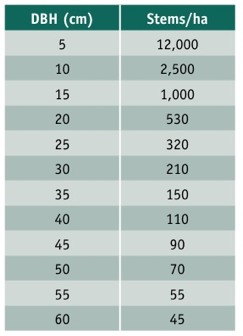
Unfortunately we do not have growth models available that would permit us to do the same simple evaluations for poplar.
However, we can see from the first two graphs that even after allowing for the stronger roots, at stockings of 50 poles per hectare and for tree sizes up to 40 cm DBH, poplar plantings fall well short of providing protection. At a stocking of 50 poles per hectare, poplar trees would have to be around 55 cm DBH before such a planting would meet the minimum protection of 30 tonnes per hectare of radiata pine equivalent root biomass.
It is a simple matter to devise a table showing the number of trees for a given DBH regardless of species required to achieve the equivalent of 30 tonnes per hectare of radiata pine root biomass.
Conclusions
This evaluation shows that there are a number of factors to take into account when assessing the effectiveness of tree plantings in reducing erosion. Large differences between species in root biomass for a given tree size are effectively cancelled out when root strength is taken into account. Smaller effects may be attributed to differences between species in rate of decay of root systems following felling.
Growth rate and number of trees per hectare are the key factors affecting how well trees control soil erosion. Provided trees of different species grow at a similar rate, and do well on exposed, erosion-prone hill slopes – although experience tells us that many do not – then it is largely a numbers game. The low stockings often employed for poplar pole planting may make them less effective for erosion control than commonly thought.

 Farm Forestry New Zealand
Farm Forestry New Zealand

